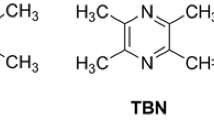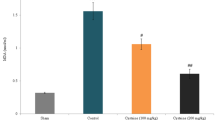Abstract
Free radicals mediated damage of phospholipids, proteins and nucleic acids results in subsequent neuronal degeneration and cell loss. Aim of this study was to evaluate the existence of lipid and protein oxidative damage and the activities of superoxide dismutase (SOD) and glutathione peroxidase (GSH-Px) in various rat brain structures 24 h after lateral fluid percussion brain injury (LFPI). Parietal cortex, hippocampus, thalamus, entorhinal cortex, and cerebellum from the ipsilateral hemisphere were processed for analyses of the thiobarbituric acid reactive substances (TBARS) and oxidized protein levels as well as for the SOD and GSH-Px activities. Immunohistochemical detection of oxidized proteins was also performed. Results of our study showed that LFPI caused significant oxidative stress in the parietal cortex and hippocampus while other brain regions tested in this study were not oxidatively altered by LFPI. GSH-Px activities were significantly increased in the parietal cortex and hippocampus, while the SOD activities remained unchanged following LFPI in all regions investigated.




Similar content being viewed by others
References
Zaloshnja E, Miller T, Langlois JA et al (2008) Prevalence of long-term disability from traumatic brain injury in the civilian population of the United States, 2005. J Head Trauma Rehabil 23(6):394–400
Corrigan JD, Selassie AW, Orman JA (2010) The epidemiology of traumatic brain injury. J Head Trauma Rehabil 25(2):72–80
Coles J (2004) Regional ischemia after head injury. Curr Opin Crit Care 10(2):120–125
Yi JH, Hazell AS (2006) Excitotoxic mechanisms and the role of astrocytic glutamate transporters in traumatic brain injury. Neurochem Int 48(5):394–403
Israelsson C, Bengtsson H, Kylberg A et al (2008) Distinct cellular patterns of upregulated chemokine expression supporting a prominent inflammatory role in traumatic brain injury. J Neurotrauma 25(8):959–974
Donkin JJ, Nimmo AJ, Cernak I et al (2009) Substance P is associated with the development of brain edema and functional deficits after traumatic brain injury. J Cereb Blood Flow Metab 29(8):1388–1398
Zhang D, Dhillon HS, Mattson MP et al (1999) Immunohistochemical detection of the lipid peroxidation product 4-hydroxynonenal after experimental brain injury in the rat. Neurosci Lett 272(1):57–61
Tyurin VA, Tyurina YY, Borisenko GG et al (2000) Oxidative stress following traumatic brain injury in rats: quantitation of biomarkers and detection of free radical intermediates. J Neurochem 75(5):2178–2189
Shao C, Roberts KN, Markesbery WR et al (2006) Oxidative stress in head trauma in aging. Free Radic Biol Med 41(1):77–85
Ansari MA, Roberts KN, Scheff SW (2008) Oxidative stress and modification of synaptic proteins in hippocampus after traumatic brain injury. Free Radic Biol Med 45(4):443–452
Wu A, Ying Z, Gomez-Pinilla F (2004) Dietary omega-3 fatty acids normalize BDNF levels, reduce oxidative damage, and counteract learning disability after traumatic brain injury in rats. J Neurotrauma 21(10):1457–1467
Wu A, Ying Z, Gomez-Pinilla F (2006) Dietary curcumin counteracts the outcome of traumatic brain injury on oxidative stress, synaptic plasticity, and cognition. Exp Neurol 197(2):309–317
Opii WO, Nukala VN, Sultana R et al (2007) Proteomic identification of oxidized mitochondrial proteins following experimental traumatic brain injury. J Neurotrauma 24(5):772–789
Ansari MA, Roberts KN, Scheff SW (2008) A time course of contusion-induced oxidative stress and synaptic proteins in cortex in a rat model of TBI. J Neurotrauma 25(5):513–526
Üstün ME, Duman A, Oğun CO et al (2001) Effects of nimodipine and magnesium sulfate on endogenous antioxidant levels in brain tissue after experimental head trauma. J Neurosurg Anesthesiol 13(3):227–232
DeKosky ST, Taffe KM, Abrahamson EE et al (2004) Time course analysis of hippocampal nerve growth factor and antioxidant enzyme activity following lateral controlled cortical impact brain injury in the rat. J Neurotrauma 21(5):491–500
Laurer HL, McIntosh TK (1999) Experimental models of brain trauma. Curr Opin Neurol 12(6):715–721
Shohami E, Shapira Y, Rosenthal J et al (1991) Superoxide dismutase activity is not affected by closed head injury in rats. J Basic Clin Physiol Pharmacol 2(1–2):103–109
Goss JR, Taffe KM, Kochanek PM et al (1997) The antioxidant enzymes glutathione peroxidase and catalase increase following traumatic brain injury in the rat. Exp Neurol 146(1):291–294
Sullivan PG, Keller JN, Mattson MP (1998) Traumatic brain injury alters synaptic homeostasis: implications for impaired mitochondrial and transport function. J Neurotrauma 15(10):789–798
Vagnozzi R, Marmarou A, Tavazzi B et al (1999) Changes of cerebral energy metabolism and lipid peroxidation in rats leading to mitochondrial dysfunction after diffuse brain injury. J Neurotrauma 16(10):903–913
Hall ED, Detloff MR, Johnson K et al (2004) Peroxynitrite-mediated protein nitration and lipid peroxidation in a mouse model of traumatic brain injury. J Neurotrauma 21(1):9–20
Petronilho F, Feier G, de Souza B et al (2010) Oxidative stress in brain according to traumatic brain injury intensity. J Surg Res 164(2):316–320
McIntosh TK, Vink R, Noble L et al (1989) Traumatic brain injury in the rat: characterization of a lateral fluid-percussion model. Neuroscience 28(1):233–244
Thompson HJ, Lifshitz J, Marklund N et al (2005) Lateral fluid percussion brain injury: a 15-year review and evaluation. J Neurotrauma 22(1):42–75
Praticò D, Reiss P, Tang LX et al (2002) Local and systemic increase in lipid peroxidation after moderate experimental traumatic brain injury. J Neurochem 80(5):894–898
Lima FD, Souza MA, Furian AF et al (2008) Na+, K+-ATPase activity impairment after experimental traumatic brain injury: relationship to spatial learning deficits and oxidative stress. Behav Brain Res 193(2):306–310
Paolin A, Nardin L, Gaetani P et al (2002) Oxidative damage after severe head injury and its relationship to neurological outcome. Neurosurgery 51:949–954
Ohkawa H, Ohishi N, Yagi K (1979) Assay for lipid peroxides in animal tissues by thiobarbituric acid reaction. Anal Biochem 95(2):351–358
Callaway JK, Beart PM, Jarrott B (1998) A reliable procedure for comparison of antioxidants in rat brain homogenates. J Pharmacol Toxicol Methods 39(3):155–162
McCord JM, Fridovich I (1969) Superoxide dismutase. An enzymic function for erythrocuprein (hemocuprein). J Biol Chem 244(22):6049–6055
Paglia DE, Valentine WN (1967) Studies on the quantitative and qualitative characterization of erythrocyte glutathione peroxidase. J Lab Clin Med 70(1):158–169
Bradford MM (1976) A rapid and sensitive method for the quantitation of microgram quantities of protein utilizing the principle of protein-dye binding. Anal Biochem 72:248–254
Hicks RR, Smith DH, Lowenstein DH et al (1993) Mild experimental brain injury in the rat induces cognitive deficits associated with regional neuronal loss in the hippocampus. J Neurotrauma 10(4):405–414
Hicks RR, Soares HD, Smith D et al (1996) Temporal and spatial characterization of neuronal injury following lateral fluid-percussion brain injury in the rat. Acta Neuropathol 91(3):236–246
Conti AC, Raghupathi R, Trojanowski JQ et al (1998) Experimental brain injury induces regionally distinct apoptosis during the acute and delayed post-traumatic period. J Neurosci 18(15):5663–5672
Manoli LP, Gamaro GD, Silveira PP et al (2000) Effect of chronic variate stress on thiobarbituric-acid reactive species and on total radical-trapping potential in distinct regions of rat brain. Neurochem Res 25(7):915–921
Župan G, Pilipović K, Hrelja A et al (2008) Oxidative stress parameters in different rat brain structures after electroconvulsive shock-induced seizures. Prog Neuropsychopharmacol Biol Psychiatry 32(3):771–777
Peternel S, Pilipović K, Župan G (2009) Seizure susceptibility and the brain regional sensitivity to oxidative stress in male and female rats in the lithium-pilocarpine model of temporal lobe epilepsy. Prog Neuropsychopharmacol Biol Psychiatry 33(3):456–462
Riegel RE, Valvassori SS, Moretti M et al (2010) Intracerebroventricular ouabain administration induces oxidative stress in the rat brain. Int J Dev Neurosci 28:233–237
Leker RR, Shohami E (2002) Cerebral ischemia and trauma-different etiologies yet similar mechanisms: neuroprotective opportunities. Brain Res Brain Res Rev 39(1):55–73
Eraković V, Župan G, Varljen J et al (2000) Lithium plus pilocarpine induced status epilepticus-biochemical changes. Neurosci Res 36(2):157–166
Eraković V, Župan G, Varljen J et al (2000) Electroconvulsive shock in rats: changes in superoxide dismutase and glutathione peroxidase activity. Brain Res Mol Brain Res 76(2):266–274
Yunoki M, Kawauchi M, Ukita N et al (1997) Effects of lecithinized superoxide dismutase on traumatic brain injury in rats. J Neurotrauma 14(10):739–746
Ding JY, Kreipke CW, Speirs SL et al (2009) Hypoxia-inducible factor-1alpha signaling in aquaporin upregulation after traumatic brain injury. Neurosci Lett 453(1):68–72
Lawler JM, Song W (2002) Specificity of antioxidant enzyme inhibition in skeletal muscle to reactive nitrogen species donors. Biochem Biophys Res Commun 294(5):1093–1100
DeKosky ST, Goss JR, Miller PD et al (1994) Upregulation of nerve growth factor following cortical trauma. Exp Neurol 130:173–177
Goss JR, O’Malley ME, Zou L, Styren SD et al (1998) Astrocytes are the major source of nerve growth factor upregulation following traumatic brain injury in the rat. Exp Neurol 149:301–309
Fan P, Yamauchi T, Noble LJ et al (2003) Age-dependent differences in glutathione peroxidase activity after traumatic brain injury. J Neurotrauma 20(5):437–445
Hellmich HL, Garcia JM, Shimamura M et al (2005) Traumatic brain injury and hemorrhagic hypotension suppress neuroprotective gene expression in injured hippocampal neurons. Anesthesiology 102(4):806–814
Shimamura M, Garcia JM, Prough DS et al (2005) Analysis of long-term gene expression in neurons of the hippocampal subfields following traumatic brain injury in rats. Neuroscience 131(1):87–97
Xiong Y, Shie FS, Zhang J et al (2004) The protective role of cellular glutathione peroxidase against trauma-induced mitochondrial dysfunction in the mouse brain. J Stroke Cerebrovasc Dis 13(3):129–137
Tsuru-Aoyagi K, Potts MB, Trivedi A et al (2009) Glutathione peroxidase activity modulates recovery in the injured immature brain. Ann Neurol 65(5):540–549
Potts MB, Rola R, Claus CP et al (2009) Glutathione peroxidase overexpression does not rescue impaired neurogenesis in the injured immature brain. J Neurosci Res 87(8):1848–1857
Halliwell B, Gutteridge JM (1984) Oxygen toxicity, oxygen radicals, transition metals and disease. Biochem J 219(1):1–14
Acknowledgments
The authors would like to thank Vedran Frković, MD for his assistance in performing some of these experiments. This research was supported by Grants 062-0620529-0519 and 062-0620529-0518 from The Ministry of Science, Education and Sports of the Republic of Croatia.
Author information
Authors and Affiliations
Corresponding author
Rights and permissions
About this article
Cite this article
Pilipović, K., Župan, Ž., Dangubić, B. et al. Oxidative Stress Parameters in Different Brain Structures Following Lateral Fluid Percussion Injury in the Rat. Neurochem Res 36, 913–921 (2011). https://doi.org/10.1007/s11064-011-0424-3
Accepted:
Published:
Issue Date:
DOI: https://doi.org/10.1007/s11064-011-0424-3




